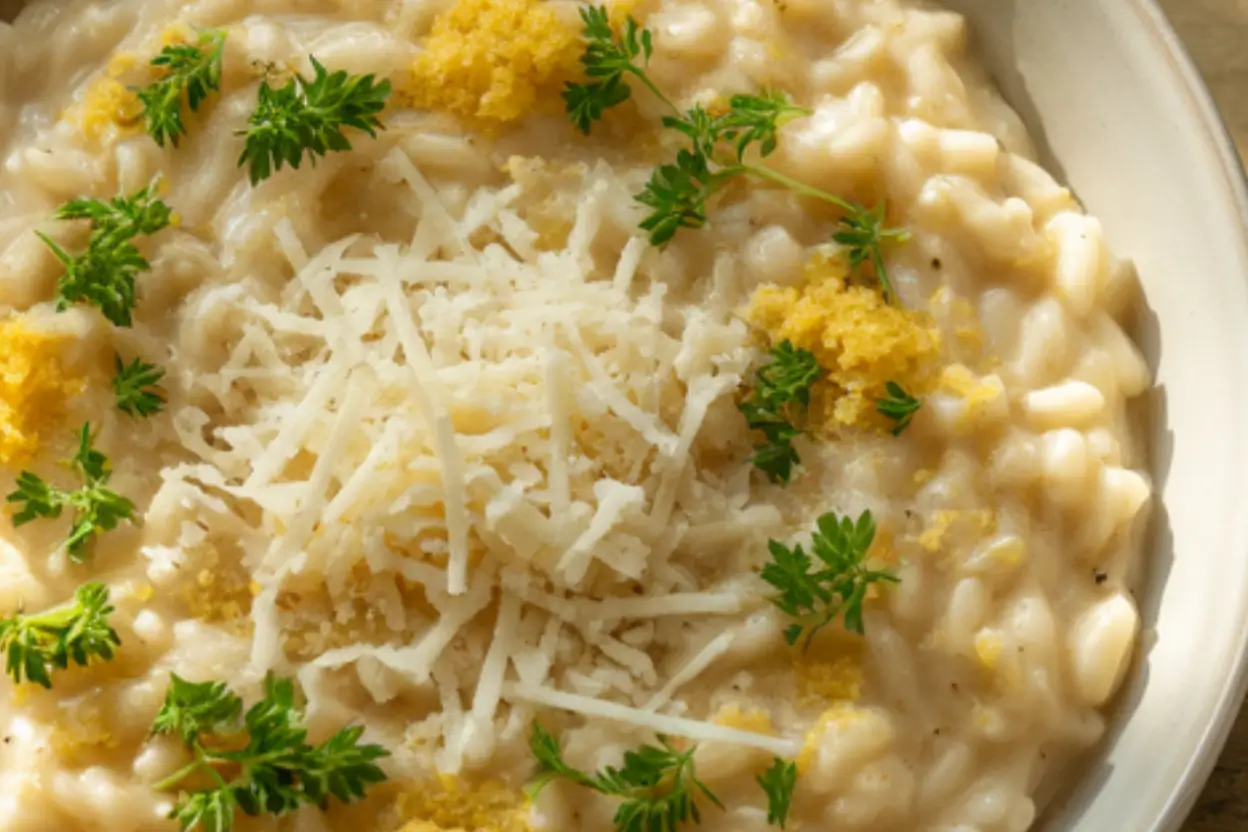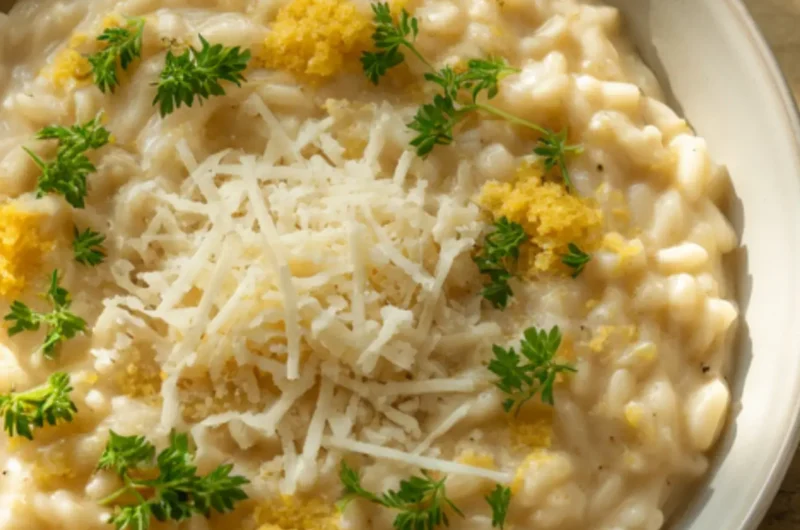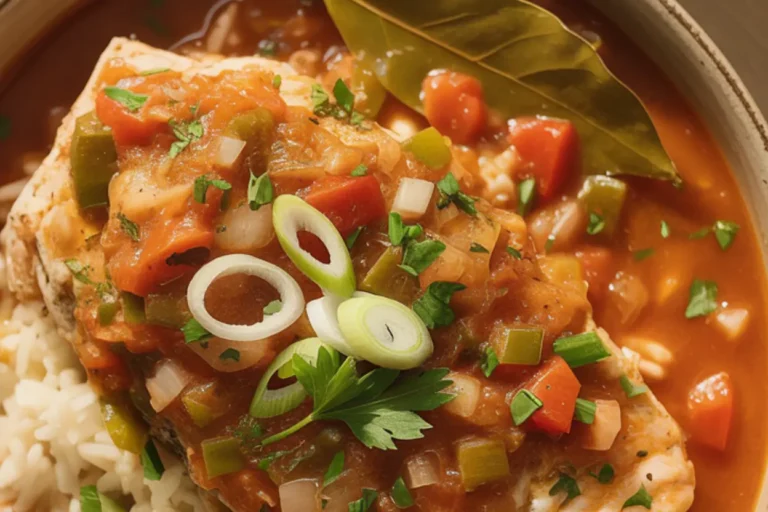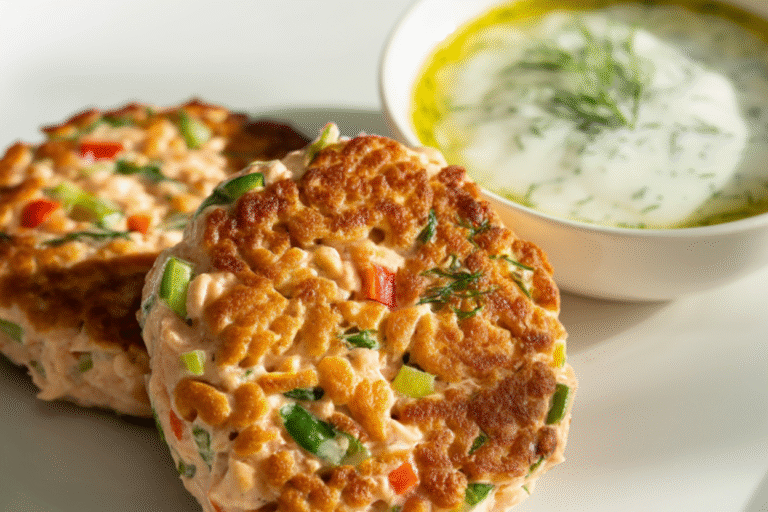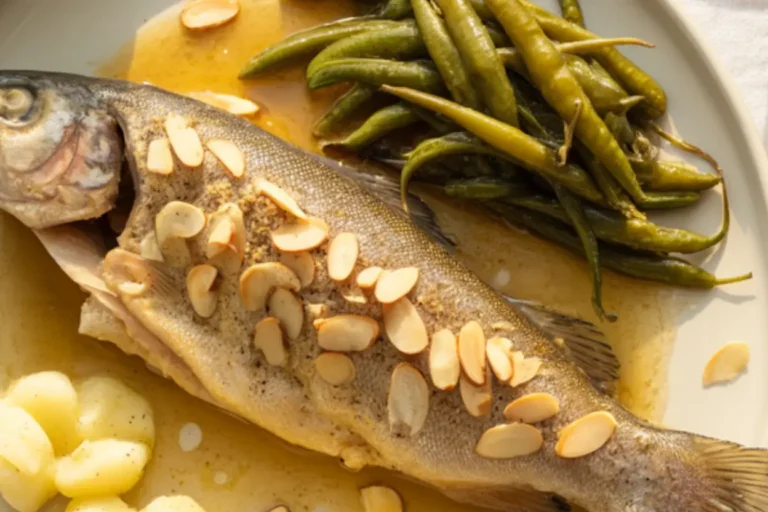Parmesan Risotto Recipe: How to Get It Rich and Silky
Table of Contents
There’s something undeniably magical about a perfectly executed Parmesan risotto. That moment when your spoon glides through the creamy, velvety rice, releasing aromatic steam infused with notes of white wine, butter, and aged cheese – it’s the epitome of comfort food elevated to an art form. Yet for many home cooks, risotto remains intimidating, surrounded by myths about constant stirring and precise timing.
Thank you for reading this post, don't forget to subscribe!After years of perfecting this classic Italian dish, I’m here to tell you that making restaurant-quality Parmesan risotto at home doesn’t require professional culinary training – just some patience, quality ingredients, and understanding the key techniques that make risotto truly exceptional. In this guide, I’ll walk you through my foolproof method for creating a Parmesan risotto that’s luxuriously creamy, perfectly al dente, and deeply satisfying. Whether you’re cooking to impress dinner guests or simply treating yourself to a bowl of comfort, this recipe delivers a taste of Northern Italian luxury right in your own kitchen.
How to Make Parmesan Risotto
Quick Overview
This Parmesan risotto delivers the perfect balance of rich, savory flavor and that distinctive creamy yet al dente texture that makes risotto such a beloved dish. What makes this version special is how it achieves remarkable creaminess without heavy cream, relying instead on the natural starches of the rice, quality stock, and the finishing touch of cold butter and aged Parmigiano-Reggiano. The result is a dish with depth and complexity that showcases the simple, quality ingredients.
The beauty of this recipe lies in its straightforward approach to what many consider a challenging dish. While risotto does require attention, it’s not as demanding as its reputation suggests. From start to finish, you’re looking at about 35 minutes of preparation and cooking time, with only about 20 minutes of that requiring your active attention at the stove. The remainder is mainly preparation and the final resting period that helps develop the perfect texture. This means you can create a truly impressive, restaurant-quality dish without spending hours in the kitchen or mastering complicated techniques. The end result is a versatile, luxurious risotto that can serve as either a sophisticated side or a satisfying main dish.
The Ingredients I Use to Bring My Parmesan Risotto to Life
- 1½ cups Arborio rice (or Carnaroli if available)
- 5 cups chicken stock (homemade preferred, or low-sodium store-bought)
- 1 cup dry white wine (such as Pinot Grigio or Sauvignon Blanc)
- 1 medium yellow onion, finely chopped (yields approximately 1 cup)
- 2 cloves garlic, minced
- 3 tablespoons unsalted butter, divided (2 tablespoons + 1 tablespoon)
- 2 tablespoons extra virgin olive oil
- 1 cup freshly grated Parmigiano-Reggiano cheese, with additional for garnish
- 2 tablespoons fresh parsley, finely chopped
- 1 teaspoon fresh thyme leaves (optional)
- 1 tablespoon lemon zest (optional, but adds brightness)
- ½ teaspoon kosher salt, plus more to taste
- Freshly ground black pepper to taste
Step-by-Step Instructions
Step 1: Prepare Your Ingredients and Heat the Stock
- Begin by gathering and prepping all your ingredients before you start cooking (mise en place). Having everything ready is crucial for risotto, as the cooking process requires your continuous attention.
- Pour the chicken stock into a medium saucepan and bring it to a gentle simmer over medium-low heat. Once simmering, reduce the heat to low to keep it hot but not boiling. The temperature of the stock is important – adding cold stock to the rice would halt the cooking process and result in uneven texture.
- Position the stock pot adjacent to where you’ll be cooking the risotto for easy access during the stirring and ladling process.
Step 2: Sauté the Aromatics
- In a heavy-bottomed, wide pan or Dutch oven (preferably with sloped sides), heat the olive oil and 2 tablespoons of butter over medium heat until the butter has melted and stops foaming.
- Add the finely diced onion to the pan and sauté for 4-5 minutes until it becomes translucent and soft, but not browned. Browning the onions will change the color and flavor profile of your finished risotto.
- Add the minced garlic and continue cooking for another 30 seconds until fragrant, being careful not to let it brown or burn, which would introduce bitterness.
Step 3: Toast the Rice
- Stir the Arborio rice into the pan with the sautéed aromatics, mixing constantly with a wooden spoon to ensure each grain is well-coated in the oil and butter. This step enhances the flavor and helps keep the rice from clumping.
- Continue stirring and cooking the rice for 2-3 minutes until the edges of the grains become translucent while the centers remain white. You should hear a light clicking sound as you stir. This toasting step is crucial for developing the rice’s ability to absorb liquid while maintaining its structure.
- The rice should not change color during this process – if it starts to brown, your heat is too high.
Step 4: Add Wine and Begin Adding Stock
- Pour in the cup of white wine and stir, allowing the pleasant sizzle as the wine hits the hot pan. Continue stirring gently until most of the wine has been absorbed by the rice, about 2-3 minutes. You’ll know it’s time to add stock when you can drag your spoon through the rice and it leaves a clear path for a moment before flowing back together.
- Using a ladle, add about ¾ cup (one ladleful) of the hot chicken stock to the rice. Adjust the heat if necessary to maintain a gentle, active simmer – not too vigorous and not too slow.
- Stir regularly, but not necessarily constantly, until most of the liquid is absorbed before adding the next ladleful. This should take about 2-3 minutes per addition.
Step 5: Continue the Cooking Process
- Continue adding the hot stock one ladleful at a time, allowing each addition to be mostly absorbed before adding the next. Stir frequently throughout this process to help release the starches from the rice, which creates the creamy consistency.
- After about 15 minutes of adding stock, begin tasting the rice to check for doneness. Perfectly cooked risotto should be al dente – tender but still with a slight firmness at the center of each grain.
- The total cooking time from the first addition of stock will be approximately 18-22 minutes, and you may not need all of the stock. The risotto is done when the rice is cooked to your liking and the texture is creamy and flowing, not stiff or soupy.
Step 6: Finish the Risotto
- When the rice is just shy of al dente (it will continue cooking slightly off-heat), remove the pan from the heat. The risotto should be slightly loose and fluid in texture – it will thicken as it sits and as you add the cheese.
- Add the remaining 1 tablespoon of cold butter, cut into small pieces, and the freshly grated Parmigiano-Reggiano cheese. The key is adding these ingredients while the risotto is off the heat, but still hot – this creates the optimal emulsion without breaking the creaminess.
- Gently fold in the butter and cheese until fully incorporated. If you’re using the optional lemon zest and thyme, add them at this stage as well.
- Cover the pan and allow the risotto to sit undisturbed for 2 minutes. This short resting time is essential for achieving the perfect final texture.
Step 7: Serve Immediately
- Uncover the risotto and give it a final gentle stir. If it appears too thick, add a small splash of warm stock to loosen it to your desired consistency. A perfect risotto should slowly flow when the plate is tilted.
- Taste the dish and, if necessary, adjust the seasoning by adding more salt and freshly ground black pepper to suit your preference.
- Portion the risotto onto warmed plates, sprinkle with the chopped fresh parsley, and add an extra grating of Parmigiano-Reggiano on top.
- Serve immediately, as risotto begins to firm up as it cools.
What to Serve Parmesan Risotto With
Parmesan risotto works beautifully as either a main dish or a sophisticated side. Here are some excellent pairing options:
As a main dish, complement with:
- A light arugula salad dressed with lemon vinaigrette and topped with shaved Parmesan.
- Roasted asparagus or broccolini with lemon and garlic
- Sautéed wild mushrooms in herbs and butter
- Prosciutto-wrapped melon for a classic Italian appetizer
- Crusty artisan bread with good olive oil for dipping
As a side dish, pair with:
- Pan-seared scallops with brown butter
- Grilled or roasted chicken with herbs
- Osso buco (braised veal shanks)
- Slow-roasted pork tenderloin
- Grilled lamb chops with rosemary
Wine pairings:
- Crisp white wines like Pinot Grigio, Soave, or Vermentino
- Light-bodied reds like Valpolicella or Pinot Noir
- Prosecco or Franciacorta for a celebratory meal
- Rosé for a versatile option that bridges flavors
Complete the meal with:
- A light dessert like panna cotta or zabaglione with fresh berries
- Limoncello served ice-cold as a digestif
- Italian-style coffee service
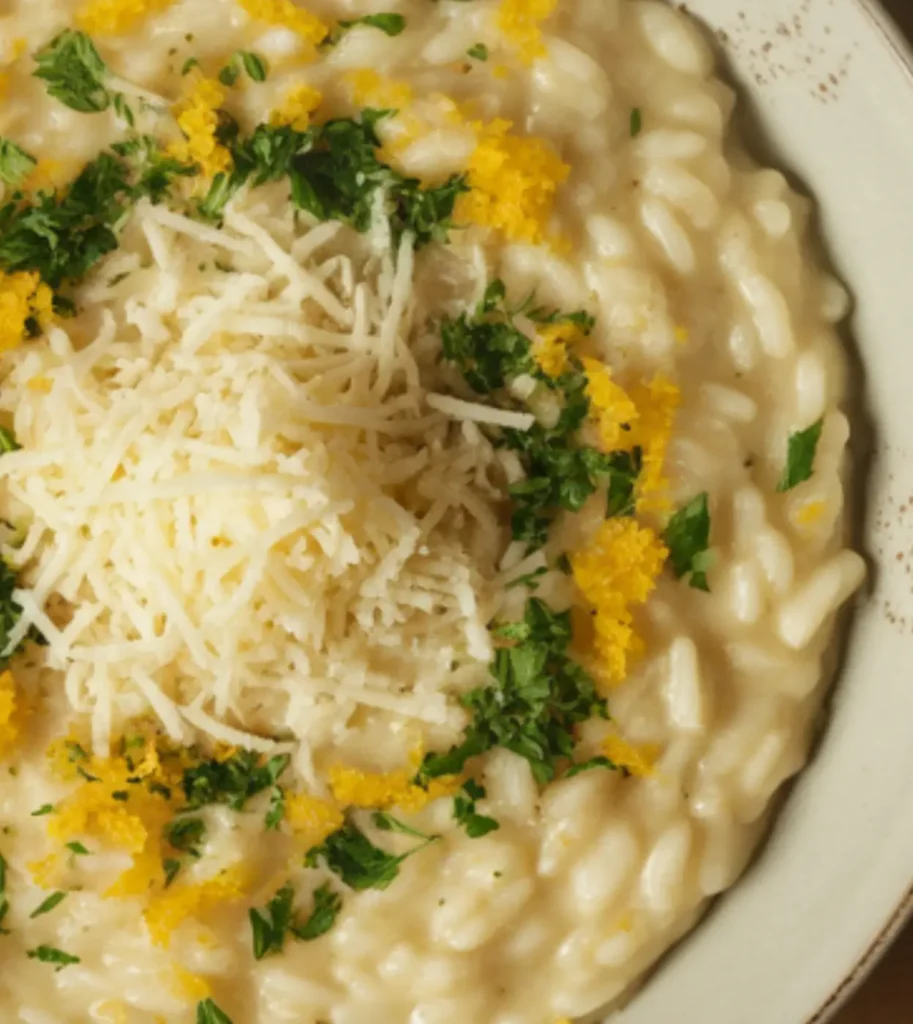
Top Tips for Perfecting Parmesan Risotto
- Choose the right rice: Arborio is the most widely available rice for risotto, but Carnaroli (often called the “king of risotto rice”) offers even better results with its higher starch content and firmer texture. Vialone Nano is another excellent option, especially for more delicate seafood risottos. Never substitute long-grain rice varieties, as they won’t produce the necessary creaminess.
- Stock temperature matters: Always keep your stock at a gentle simmer while cooking risotto. Cold stock shocks the rice and halts the cooking process, while boiling stock can cook the outside of the rice too quickly before the inside is tender, resulting in an uneven texture.
- The stirring myth: Contrary to popular belief, you don’t need to stir risotto constantly. Regular stirring is important to release the starches and prevent sticking, but you can take short breaks. The key is not letting the rice dry out completely between stock additions and maintaining a gentle, even cooking process.
- Wine selection: Use a dry white wine that you would enjoy drinking, as the flavor concentrates during cooking. Avoid oaky wines like some Chardonnays, which can introduce unwanted flavors. If you prefer not to use alcohol, substitute with additional stock and a splash of lemon juice for acidity.
- The perfect texture: Achieving the ideal consistency, known in Italian as “all’onda” (meaning “wave-like”), is crucial. When you shake the pan gently, the risotto should flow slowly like lava, not sit stiffly or slosh like soup. If your finished risotto is too thick, add a small amount of warm stock; if too thin, let it rest an extra minute off the heat.
- Cheese considerations: Always use freshly grated Parmigiano-Reggiano for authentic flavor. Pre-grated cheeses often contain anti-caking agents that affect texture and melting properties. For variations, you can substitute or combine with Grana Padano (milder) or add a small amount of Pecorino Romano for a sharper edge.
- Troubleshooting common issues:
- Risotto is too crunchy: Rice needs more cooking time and liquid
- Risotto gluey or mushy: Rice was overcooked or stirred too vigorously, breaking the grains
- Risotto bland: Insufficient seasoning during cooking – taste and adjust salt levels throughout the process
- Risotto is too thick: Add additional warm stock or a touch of butter to loosen
Storing and Reheating Tips
While risotto is truly at its best when freshly made and served immediately, here are some practical tips for storing and reviving leftovers:
Short-term storage:
- Allow risotto to cool completely before refrigerating
- Store in an airtight container in the refrigerator
- Keep for up to 2-3 days maximum
- Expect the texture to firm up considerably when chilled
Freezing options (not ideal but possible):
- Risotto can be frozen for up to 1 month in airtight containers
- Leave some room for expansion when packaging
- Thaw overnight in the refrigerator before reheating
- Accept that the texture will never be quite the same as freshly made
Reheating methods:
For best results:
- Stovetop method: Place cold risotto in a pan with a splash of hot stock or water (about 2-3 tablespoons per cup of risotto). Heat over medium-low heat, stirring gently until creamy and heated through. Add a small pat of butter at the end to refresh the texture.
Alternative methods:
- Microwave: Place a portion in a microwave-safe bowl with a tablespoon of stock or water. Cover with a damp paper towel and heat at 70% power in 30-second intervals, stirring between each until heated through. Finish with a small piece of butter and a sprinkle of fresh Parmesan.
Creative repurposing ideas:
- Arancini: Form cold risotto into balls around a small piece of mozzarella, bread, and deep-fry for classic Italian rice balls
- Risotto cakes: Shape the risotto into patties, coat them in breadcrumbs, and pan-fry until golden brown for a crisp crust and creamy center.
- Impromptu rice soup: Thin leftover risotto with additional warm stock for a quick and satisfying soup
Quality checks:
- When reheating, the risotto should never boil, which would break the creamy emulsion
- If your reheated risotto seems dry or stiff, gradually add small amounts of warm stock until the desired consistency is reached
- A fresh grating of Parmesan and a dash of herbs can brighten and restore the flavors of reheated risotto.
A perfectly executed Parmesan risotto represents the beautiful intersection of technique and simplicity, where quality ingredients combine through a thoughtful process to create something truly greater than the sum of its parts. The rich, velvety texture and complex umami flavors make it one of the most satisfying dishes in the Italian culinary repertoire.
What I love most about this dish is how it rewards your attention with immediate, tangible results – that moment when the final addition of butter and cheese transforms the gently simmered rice into a glossy, luxurious creation is nothing short of culinary alchemy. While it does require your presence and engagement during the cooking process, the techniques themselves are straightforward and accessible to cooks of all skill levels.
Whether you’re serving this Parmesan risotto as an elegant first course for a special occasion, as a comforting main dish on a chilly evening, or as the perfect accompaniment to simply prepared proteins, mastering this technique opens up endless possibilities for creative variations while maintaining the soul-satisfying essence that makes risotto such a beloved classic.
click here to follow me on pinterest
Parmesan Risotto Recipe: How to Get It Rich and Silky
Cuisine: ItalianDifficulty: Moderate4
servings10
minutes45
minutes480-520
kcalParmesan Risotto is a creamy, comforting Italian rice dish known for its velvety texture and rich, cheesy flavor. Made with Arborio rice, sautéed aromatics, white wine, and finished with freshly grated Parmigiano-Reggiano, this dish is perfect as a main course or a decadent side. The constant stirring releases the rice’s natural starch, creating a luscious consistency that’s elevated with butter, herbs, and a touch of lemon zest for brightness.
Ingredients
1½ cups Arborio rice (or Carnaroli if available)
5 cups chicken stock (homemade preferred, or low-sodium store-bought)
1 cup dry white wine (such as Pinot Grigio or Sauvignon Blanc)
1 medium yellow onion, finely chopped (yields approximately 1 cup)
2 cloves garlic, minced
3 tablespoons unsalted butter, divided (2 tablespoons + 1 tablespoon)
2 tablespoons extra virgin olive oil
1 cup freshly grated Parmigiano-Reggiano cheese, with additional for garnish
2 tablespoons fresh parsley, finely chopped
1 teaspoon fresh thyme leaves (optional)
1 tablespoon lemon zest (optional, but adds brightness)
½ teaspoon kosher salt, plus more to taste
Freshly ground black pepper to taste
Instructions
- Prep Ingredients & Heat the Stock
Gather all your ingredients (mise en place). Bring the chicken stock to a gentle simmer in a saucepan, then keep it warm on low heat. Place it close to your cooking area for easy access. - Sauté the Aromatics
In a wide pan, heat olive oil and 2 tablespoons of butter over medium heat. Sauté the chopped onion until soft and translucent (about 4–5 minutes), then add garlic and cook for 30 seconds without browning. - Toast the Rice
Add Arborio rice to the pan and stir constantly for 2–3 minutes to coat each grain in the fat. The grains should become slightly translucent around the edges—don’t let them brown. - Deglaze with Wine & Start Adding Stock
Pour in white wine and stir until mostly absorbed. Begin adding hot stock one ladle at a time, stirring regularly. Let each addition absorb before adding the next. - Stir & Simmer Until Tender
Continue adding stock and stirring for 18–22 minutes. Taste occasionally; the rice should be al dente with a creamy, flowing consistency. You may not need all the stock. - Finish Off Heat
Remove from the heat just before the rice is fully cooked. Stir in the last tablespoon of butter and Parmesan cheese. Add lemon zest and thyme if using. Cover and let rest for 2 minutes. - Plate & Serve
Uncover, stir gently, and adjust texture with a splash of stock if needed. Season to taste. Plate onto warm dishes, top with parsley and extra Parmesan. Serve immediately while hot and creamy.
Notes
- This risotto showcases the elegance of simplicity—relying on high-quality ingredients like real Parmigiano-Reggiano, good wine, and homemade stock can make a big difference in flavor. Don’t rush the stirring process; it’s what builds the creamy texture without any added cream. Optional lemon zest adds a light, fresh contrast to the richness of the cheese. Ideal for dinner parties or cozy nights in.

